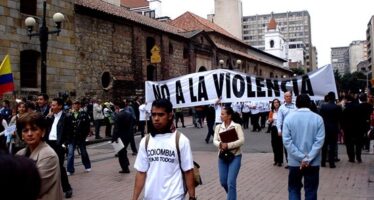Turkey’s few women’s shelters struggle to meet huge need for services
![]()
SEFA KAPLAN
ISTANBUL
It seems that not a day goes by without news about women battered by their husbands and lovers or about women who are killed in the middle of the street. Women’s shelters open doors to women and children who survive violence but there are only 65 women shelters in a country of 70 million – a number that doesn’t close enough to meeting the need

Although every municipality with more than 50,000 people is required by law to open a shelter, many jurisdictions do not take the obligation seriously. Hürriyet photo
A lack of responsibility on the part of municipal authorities around Turkey is partly to blame for the low number of women’s shelters in the country, an official from a prominent women’s support group has said.
“Many municipalities see [constructing a shelter] as a favor, not an obligation, for they neither aim to fight against domestic violence nor fulfill the requirements of the state,” said Zelal Yalç?n of the Mor Çat? (Purple Roof) group. “As such, some municipalities see building women shelters as a public relations campaign and hold opening ceremonies.”
Mor Çat? is an initiative from a group of pioneering feminists who brought the issue of domestic violence to the agenda and began to work for the creation of the first women’s shelter in Turkey in 1995.
There are women’s shelters in Istanbul in Küçükçekmece, Üsküdar, Pendik, Kad?köy and Bak?rköy municipalities. Although every municipality with more than 50,000 people is required by law to open a shelter, many jurisdictions do not take the obligation seriously; for those that do not, there is no sanction for noncompliance.![]() Seven shelters from UN
Seven shelters from UN
There is slow but steady progress in terms of educating public service workers about domestic violence, according to United Nations Population Program Coordinator Meltem A?duk.
“I am one of those who see the full side of the glass. A friend of mine had once said ‘The Women’s Movement poured corn into a pan 30 years ago and now they are popping.’ It is indeed; especially in the last six or seven years awareness has increased enormously and women have started to speak up,” said A?duk.
Police forces have been more involved in the issue since 2006, receiving more training, said A?duk, adding that there were discussions to establish a domestic violence unit at the Police Department.
“But I have to underline that this is a mentality issue. We are trying to make changes by struggling against a patriarchal mindset,” she said. “And that could take some time, but I think Turkey is making speedier progress on the subject compared to other countries. By 2015, training sessions will be provided to 40,000 police officers, 75,000 health personnel, 100,000 religious clerics and all judges of the Family Court, as well as prosecutors. These are critical figures.”
Hürriyet ‘Hello, Violence in Family’ Line
* Daily Hürriyet’s “Hello Violence in Family Line,” which started Oct. 15, 2007, has received about 24,000 phone calls beginning operation. The calls are not limited to Turkey, as there are calls from even Germany, France, Austria, Azerbaijan, Belgium, the Netherlands, Australia, the United States, Syria, Switzerland, Iran, Tunisia, and Turkish Cyprus. A total of 6,442 callers were either the victim or relatives of the victims. One of every two victims complained about physical abuse.
Attackers call, too
* Not only the victims but a total of 121 attackers also called the hotline, 12 of whom said they resorted to violence but did not want to do so anymore. Three called to make insults while the rest called to ask for the locations of their wives who had sought shelter in the facilities.
797 emergency cases
* There have been a total of 797 emergency cases so far, mostly to which teams of officials were sent and shelters were provided for a considerable number of battered women. One of the calls was for a suicide case. The woman who was saved from four attempts of suicide was hospitalized with the assistance of the Province Health Directorate and the Social Services and Child Protection Agency, or SHÇEK.
There are currently only 65 women shelters in Turkey, but there would be roughly 1,400 if the law were properly implemented.“The number of women shelters is not enough to meet the need. For instance, an average of 10 women call us each day, at least half of whom ask for shelter, almost all want to have more information and ask whether or not they can come anytime they want to,” said Yalç?n.
For those working at the shelter in Küçükçekmece, one of the oldest in the country and dating from 1995, the learning curve for helping abused women was extremely steep.
“We didn’t know anything [at the beginning]; not how to treat a battered woman, or how we should take care of the children, or how a woman could hide from the violence of a husband… But we learned everything in time. And now we organize seminars and conferences for the new shelters,” said the manager Saniye, whose real name has to be concealed due to safety reasons.
Daycare center a necessity for shelters
Shelters provide a safe heaven not only for women but also children as most women come with their children.
It is very difficult to witness the suffering of the children who come here with their mothers, said Nergis, another official at the Küçükçekmece facility whose real name was also withheld for her safety.
“I heard children saying, ‘Mom, don’t open the curtain, daddy will come to find us.’ I saw children peeing their pants as they hear the word ‘daddy,’” Nergis said.
It is meaningless to have a shelter unless there is a daycare center, she said. “Women come here with their children. A woman who cannot take care of her children can hardly stand on her feet. For that reason, we tell everyone that daycare centers are a priority for shelters.”
The mission of the shelters is not simply limited to providing a safe roof to battered women. Shelters remain in touch with women who are “discharged” from the facility, like patients from a hospital; they hire and furnish houses for women with the help of civil society organizations, municipalities and district governorships. They even beg, if necessary, to private teaching institutions to provide scholarships to the children of battered women and find jobs for them, according to information provided by shelter officials.
“It is a passion for us to visit them later, have a cup of coffee and see how happy these women are together with their children in their own houses. We helped 14 battered women acquire and furnish houses in 2010,” said another Küçükçekmece shelter official.
Studio houses for the victims
Provincial Health Directorates and the Social Services and Child Protection Agency, or SHÇEK, also run shelters for women and children in addition to municipalities and nongovernmental organizations.
Two-thirds of the shelters in Turkey are run by SHÇEK. “My door is open to any woman who saysi ‘I need a shelter, I am subjected to violence in family.’ I welcome any woman who applies to me. We have every kind of facility to welcome battered women. If one is in trouble, she should call me right away,” said SHÇEK director ?smail Bar??.
Despite the optimistic statements, he doesn’t hesitate to acknowledge that Turkey lags 30 years behind Europe on the subject matter. “Right now, we are at a point where we should’ve been 15 years ago,” he said.
Help stations
Bar?? said there were approximately 150 locations in Turkey that women could contact when in danger.
“Each woman who calls these stations is accommodated. Of course we can not accommodate them all at the same place. Let’s say that if a woman applies to us in Istanbul, she can be protected in Kocaeli, or similarly to the one that applies from Kocaeli, she can be protected in Bursa,” he said.
Bar?? said they accommodated women in hotels or even rented houses, if necessary.
There are 40 Women’s Guest Houses affiliated with SHÇEK, Bar?? said, adding that 50 to 74 new guest houses were planned in the 2011 budget.
However, the figure is quite low given that there are 499 women’s shelters in Germany and 293 in Spain.
Bar?? said small studios could provide a quicker remedy. “I think the most idealistic way is the implementation of studio houses. These women do not return to their original families or to their husbands. We plan to assign studio houses to them until they find a job and manage to stand alone on their feet. They can stay in these houses for a few years. We reached an agreement with Housing Development Administration, or TOK?, to build studio houses for us.”
Meanwhile, he drew attention to another problem about shelters; the lack of social service officials:
“There are 13,000 social service officials in Israel, we have only 3,000. Think that there were only 33 PhD students from 1961 to 2000 in this area of study. Be my guest to calculate the population ratio. However, we are not running away from our responsibilities by citing the shortcomings. Our budget increased 30 times in three years. We do our job rather than complain,” said Bar??.
Related Articles
INFORME PRELIMINAR VIOLACION DE DDHH EN COLOMBIA
![]()
Informe preliminar violacion de Ddhh en Colombia de la Misión Internacional de Solidaridad y Observación de Derechos Humanos
El proyecto de ley “para el reconocimiento y protección de las personas defensoras de derechos humanos y defensoras del medio ambiente”
![]()
En la Gaceta Oficial de Costa Rica del 30 de marzo del 2023, se publicó el Proyecto de Ley 23.588: se denomina “Ley para el reconocimiento y protección de las personas defensoras de derechos humanos y defensoras del medio ambiente”.
IRAN MUST END HARASSMENT OF STONING CASE LAWYER
![]()
Mostafaei is defending Sakineh Mohammadi Ashtiani, who was sentenced to stoning © Private Amnesty International has urged the Iranian authorities to




